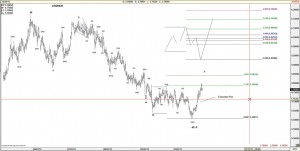The Expanded Flat correction is a common corrective structure seen in:
-
- Wave 2 and Wave 4 of a Motive Wave
- The connector wave in a Zig Zag pattern
- Any part of a Double or Triple Correction
Structure of an Expanded Flat Correction
In a Bullish Trend Scenario:
- Wave A – Price moves against the trend in a 3-wave structure.
- Wave B – Also a 3-wave structure that advances beyond the origin of wave A, typically reaching 123.6% of wave A.
- Invalidation level: Above 161.8% of wave A
- Wave C – Must be a 5-wave (Motive Wave) structure with RSI divergence between wave 3 and 5.
- Common completion zones: 100% – 123.6% extension of wave A
- Invalidation: Beyond 161.8% extension
- Running Flat: When wave C ends above wave A
Sign up for a 14-Day Trial HERE
Visual Example of an Expanded Flat Correction
Why Traders Get Confused
Expanded Flat corrections often mislead traders because:
-
- After Wave A completes as a 3-wave move, price retraces beyond Wave A’s origin, making traders think the correction is over.
- However, a sharp 5-wave reversal (Wave C) follows, completing the structure.
Real Market Example (Bearish Trend)
Here is a real market example that features a bearish trend.
Safe Trading
Graham Lowe
Back

